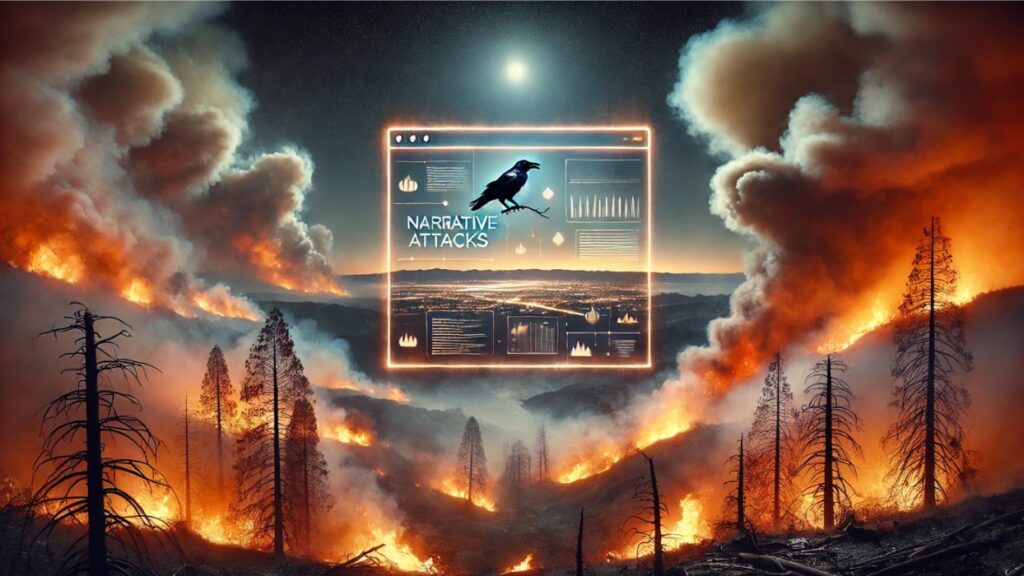How the California Wildfires Sparked Divisive Narrative Attacks
Social media became a battleground of manipulated narratives, with agenda-driven actors amplifying misleading claims targeting officials, influencers, firefighters, and government organizations during the Los Angeles wildfire crisis.

Image: Dall-E 3
Unprecedented wildfires in Los Angeles County, California, continue to burn, fueled by strong Santa Ana winds and severe drought. With thousands of structures destroyed – including multimillion-dollar homes – and at least 27 fatalities, shock turned into speculation on social media, creating an ideal breeding ground for narrative attacks to thrive.
Blackbird.AI’s RAV3N Narrative Intelligence and Research Team analyzed online narratives during the wildfire outbreak. They identified five key narrative attacks that confused and sowed doubt of the people impacted and those watching as the devastation unfolded. Leveraging insights from Blackbird.AI’s Constellation Intelligence Platform and Compass by Blackbird.AI, the RAV3N team found elevated bot-like activity across the following five narratives, suggesting that inauthentic amplification was used as a strategy to spread harmful narrative attacks.
LEARN: What Is Narrative Intelligence?
Narrative Attack 1: Decisions and policy failures by the California Governor and Los Angeles Mayor failed to contain the spread of the wildfires
The most significant narrative attack emerged from criticism of California Governor Newsom and Los Angeles Mayor Bass. During crises, online actors will likely launch narrative attacks against elected officials to place blame. Hyper-agenda-driven communities amplified misleading claims that Newsom was responsible for water supply issues, which stemmed from local infrastructure problems rather than state-level decisions. These same actors targeted Bass for changes to the Los Angeles Fire Department’s budget, claiming that cuts she initiated were to blame for the wildfires spinning out of control. While Bass did approve a $17.6 million reduction in the department’s budget, the overall budget increased due to additional funding for salaries and equipment. Moderate bot-like activity and high negative sentiment in this narrative indicate an attempt to amplify posts with inflammatory language inorganically.
LEARN MORE: The World Economic Forum recently ranked narrative attacks created by misinformation and disinformation as the #1 global risk for the second consecutive year. Harmful narratives also fan the flames of the top five risks, including extreme weather, state-based armed conflict, societal polarization, and cyber espionage. Check out the report here.
Narrative Attack 2: The Los Angeles County Fire Department’s Diversity, Equity, and Inclusion (DEI) hiring practices resulted in not enough qualified firefighters to aid in containing the wildfires
Prominent agenda-driven influencers propelled this narrative into widespread circulation. They paved the way for large-scale discourse targeting Los Angeles County Fire Chief Kristin Crowley and offering criticism of the Fire Department’s DEI policies and hiring practices. These communities argued that DEI was a source of the problem as they did not have enough skilled firefighters to fight the blaze and implied that Crowley was incompetent as the chief because she is a woman. High bot-like activity and negative sentiment in this narrative suggest that high-impact influencers using provocative messaging benefited from the circulation efforts of inauthentic accounts.
Narrative Attack 3: Unhoused people, undocumented immigrants, and criminal groups committed arson by starting the wildfires, possibly with the intent to loot wealthy homes
Hyper-agenda-driven communities leveraged imagery of unhoused people lighting fires to stay warm to spread further claims that unhoused people were to blame for the wildfires. These actors referenced allegations that an unhoused person was arrested for attempting to light a fire, using this information to further a narrative attack. Others leveraged apprehension toward undocumented immigrants, playing into fears that the fires were agenda-driven and criticizing Newsom’s immigration policies. Additionally, the concern that evacuated homes were being looted further boosted claims that the fires were started intentionally so that unhoused people, undocumented immigrants, and criminal groups could steal items from wealthy homes.
Narrative Attack 4: The federal government neglected US citizens in need in California in by sending additional aid to Ukraine
Online actors leveraged news of the US government sending additional aid to Ukraine to bolster assertions that the federal government did not care about US citizens in need in California. Narratives claimed that the aid sent to Ukraine should have been sent to California to help fight the wildfires. Additionally, a smaller subset of actors noted that the Los Angeles County Fire Department sent aid to Ukraine, prompting a response from Ukrainian President Zelensky, who offered to send support to fight the wildfires in California. Moderate bot-like activity and anomalous activity were present in this narrative. Anomalous activity refers to unusual patterns of content propagation, and when coupled with elevated bot-like activity, this could indicate a coordinated campaign to amplify this narrative inorganically.
Narrative Attack 5: The wildfires are part of an insurance scam ploy
This narrative attack stemmed from conversations around the destruction of celebrities’ homes. Threat actors alleged that the wildfires must have been premeditated by real estate and insurance companies for profit. Discourse contained assertions that the wealthy benefited from an insurance scam and that there was a ploy to devalue the land so it could be bought for less. Actors drew on inflammatory discourse targeting insurance companies, speculating they were taking advantage of the situation. This narrative also exhibited inauthentic coordination, signaled by high bot-like activity and moderate anomalous activity.
The Way Forward
Narrative attacks during quickly evolving natural disaster events prey on disbelief to spark speculative discourse, blaming organizations and amplifying hyper-agenda-driven echo chambers. Tools like Blackbird.AI’s Constellation Narrative Intelligence Platform and Compass by Blackbird.AI aid in identifying and assessing the risk of these adverse narratives.
- To receive a complimentary copy of The Forrester External Threat Intelligence Landscape 2025 Report, visit here.
- To learn more about how Blackbird.AI can help you in these situations, book a demo.
Emily Kohlman • Intelligence Analyst
Emily is an intelligence analyst based in New York with a background in journalism. She speaks Russian and was previously a Fulbright Fellow in the Czech Republic.
Emily is an intelligence analyst based in New York with a background in journalism. She speaks Russian and was previously a Fulbright Fellow in the Czech Republic.
Learn More from our RAV3N Intelligence Team:
Need help protecting your organization?
Book a demo today to learn more about Blackbird.AI.



